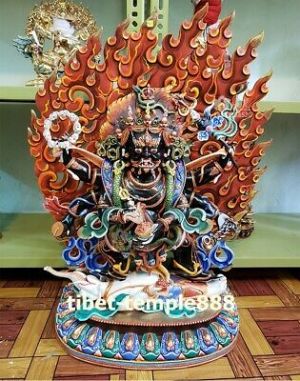Difference between revisions of "Abhidharma school [毘曇宗]"
(Created page with " Abhidharma school [毘曇宗] (; Chin P’i-t’an-tsung; Bidon-shū): Also known as the P’i-t’an school. One of the so-called thirteen schools...") |
|||
| Line 1: | Line 1: | ||
| + | [[File:$ 1 mahhakala.jpg|thumb]] | ||
| + | [[Abhidharma school]] [[[毘曇宗]]] (; [[Chin P’i-t’an-tsung]]; <nowiki>[[Bidon-shū]]</nowiki>): Also known as the <nowiki>[[P’i-t’an schoo]]</nowiki>l. One of the so-called thirteen schools of [[Chinese Buddhism]], the [[Abhidharma school]] prospered in northern [[China]] during the [[Northern]] and {{Wiki|Southern Dynasties}} period (439–589). It based its teachings on [[abhidharma]] works such as <nowiki>[[Dharmashrī’s]]</nowiki> [[Heart of the Abhidharma]] and <nowiki>[[Dharmatrāta’s]]</nowiki> Supplement to “[[The Heart of the Abhidharma]].” Hence the [[name]] of the | ||
| − | + | [[Abhidharma school]]. <nowiki>[[P’i-t’an]]</nowiki> is the {{Wiki|Chinese}} transliteration of [[abhidharma]]. The [[Sanskrit]] term [[abhidharma]] means [[doctrinal commentary]], one of the [[three divisions]] of the [[Buddhist canon]], the other two being [[sutras]] and [[vinaya]] ([[rules of monastic discipline]]). The [[twenty Hinayana schools]] in [[India]], particularly | |
| − | [[Abhidharma school]] | ||
| − | |||
| − | |||
the [[Sarvāstivāda]], produced [[abhidharma]] works. During the [[Northern]] and {{Wiki|Southern Dynasties}} period in [[China]], they were regarded as [[essential]] references on | the [[Sarvāstivāda]], produced [[abhidharma]] works. During the [[Northern]] and {{Wiki|Southern Dynasties}} period in [[China]], they were regarded as [[essential]] references on | ||
| − | [[Buddhist doctrine]]. Later in the seventh century, when [[Hsüan-tsang]] translated The [[Dharma Analysis Treasury]], [[The Great Commentary on the Abhidharma]], and other [[abhidharma]] works into {{Wiki|Chinese}}, the [[Dharma Analysis Treasury]] (Chü-she) school absorbed the rapidly declining [[Abhidharma school]]. | + | [[Buddhist doctrine]]. Later in the seventh century, when [[Hsüan-tsang]] translated The [[Dharma Analysis Treasury]], [[The Great Commentary on the Abhidharma]], and other [[abhidharma]] works into {{Wiki|Chinese}}, the [[Dharma Analysis Treasury]] (<nowiki>[[Chü-she]]</nowiki>) school absorbed the rapidly declining [[Abhidharma school]]. |
Latest revision as of 13:42, 10 April 2021
Abhidharma school [毘曇宗] (; Chin P’i-t’an-tsung; [[Bidon-shū]]): Also known as the [[P’i-t’an schoo]]l. One of the so-called thirteen schools of Chinese Buddhism, the Abhidharma school prospered in northern China during the Northern and Southern Dynasties period (439–589). It based its teachings on abhidharma works such as [[Dharmashrī’s]] Heart of the Abhidharma and [[Dharmatrāta’s]] Supplement to “The Heart of the Abhidharma.” Hence the name of the
Abhidharma school. [[P’i-t’an]] is the Chinese transliteration of abhidharma. The Sanskrit term abhidharma means doctrinal commentary, one of the three divisions of the Buddhist canon, the other two being sutras and vinaya (rules of monastic discipline). The twenty Hinayana schools in India, particularly
the Sarvāstivāda, produced abhidharma works. During the Northern and Southern Dynasties period in China, they were regarded as essential references on
Buddhist doctrine. Later in the seventh century, when Hsüan-tsang translated The Dharma Analysis Treasury, The Great Commentary on the Abhidharma, and other abhidharma works into Chinese, the Dharma Analysis Treasury ([[Chü-she]]) school absorbed the rapidly declining Abhidharma school.
